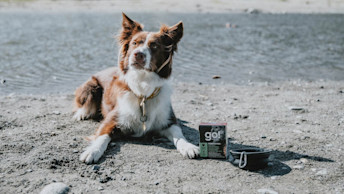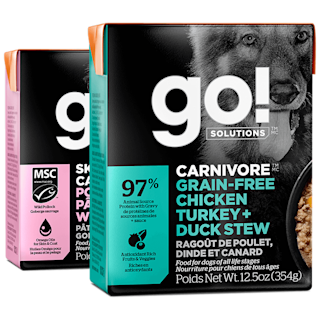August 13, 2021
The Benefits of Wet Food for Your Dog

Choosing the best food for our dogs is one of the most important decisions we can make as a pet parent. If you haven’t thought about adding wet food to your dog’s diet, now may be the perfect time! Not only can wet food add some variety to your dog's current diet, but it can also provide various health benefits.
Wet Food Versus Kibble
As they say, variety is the spice of life, and wet food is a terrific way to accomplish this for your dog's diet. Wet food comes in many different textures – stew, shredded, minced and pâté. One of our newest packaging options, Go! Solutions Tetra Paks, is a sustainable, convenient, easy-to-use, and resealable carton that offers delicious and premium ingredients like premium quality animal protein and antioxidant-rich fruits and veggies. Yum!

Recommended Solutions
Pocket-sized paks of solutions-based nutrition
Formulated to provide solutions for dogs’ unique dietary needs including picky eating, dandruff or dull coat, and food allergies or sensitivities.
View wet food recipes
As the name suggests, the moisture content of wet food is much higher than kibble. While kibble typically contains 8-12% moisture, wet food may run as high as 82% moisture! This can make it tricky to compare the nutrient content of wet food and kibble because the Guaranteed Analysis is reported on an 'as fed basis' on the label. For example, when comparing a wet food with 8% protein and 78% moisture to kibble with 26% protein and 10% moisture, the values first need to be converted to a 'dry matter basis' which is best best for direct comparisons or 'per kcal basis'.
But, don't worry about the math! At Go! Solutions, we provide these values for you in the nutrient profiles on our website.
Another unique difference between kibble and wet food is that unlike kibble, which requires carbohydrates to help create a crunchy texture, wet food can be formulated with lower levels of carbohydrates. Because wet food recipes generally include higher amounts of meat, this results in higher levels of protein and fat and lower levels of carbohydrate. Therefore, wet food makes an excellent option for those puppies and dogs who may require a higher protein, lower carb diet.
Benefits of Wet Food
Some of the benefits of feeding your dog a wet food diet include:
- Appealing to picky eaters
- Enhanced flavours and variety
- Easy to chew and digest
- Higher moisture content to support hydration
Wet food is also ideal for dogs with dental issues or missing teeth that need a soft diet.
Choosing a Wet Food for Your Dog
When choosing the right wet food for your dog, be aware that not all wet foods are appropriate to be fed as the only source of nutrition. Therefore, it's essential to make sure to read the nutritional adequacy statement found on the carton. If the food states that it's "formulated to meet the AAFCO nutrient profiles for a given life stage" then rest assured it's complete and balanced and can be fed as your dog's primary source of nutrition.
Adding Wet Food to Your Dog’s Diet
Your dog's diet can include wet food in multiple different ways. Not only can you feed your dog Go! Solutions wet food recipes in Tetra Pak cartons for a complete and balanced meal, but it can also be incorporated as a topper or a healthy treat!
Keep in mind that if you decide to feed wet food as a topper to kibble, it's essential to cut back on the amount of kibble you are currently providing to avoid weight gain.
Additionally, if you use wet food as a treat, there are unique ways to incorporate it, such as filling a Kong or freezing the food in ice cube trays for a cool treat in the hot summer months! Most of our Go! Solutions wet food recipes are similar to our kibble formulas to ensure your dog has an easy transition with similar flavours.
If transitioning your dog to a new diet they haven't tried before, allow a minimum of 10 days. A slow transition will help ensure their system has had a chance to adapt to the change and avoid digestive upset.
When it comes to mealtime, our four-legged companions appreciate a variety in diet as much as we do. If your dog isn’t taking to wet food right away, you can always try mixing both wet and dry to make the transition easier.



